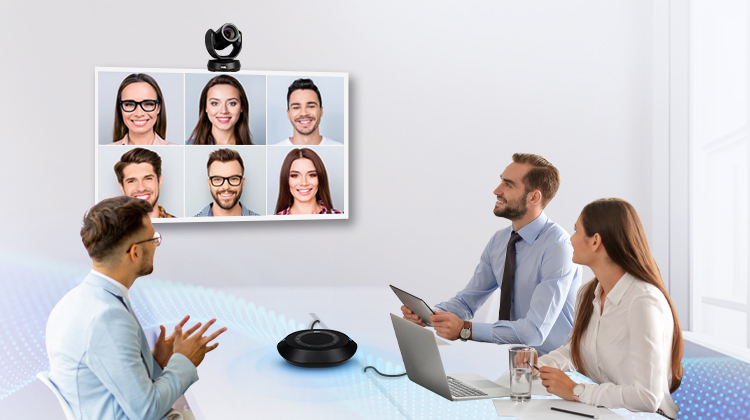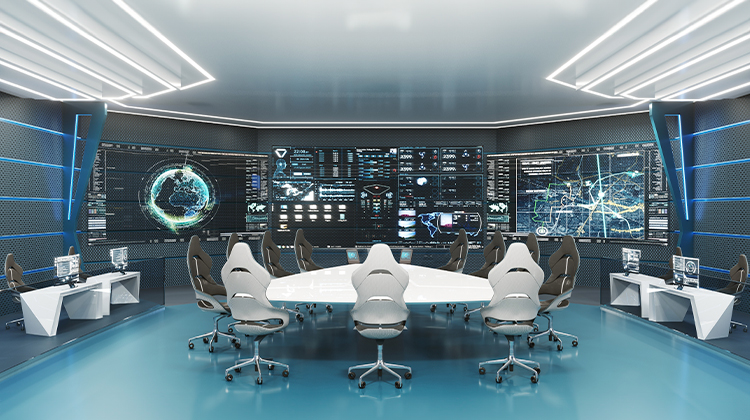Designing a video conference meeting room for the modern day workplace is not just about installing cameras and microphones — it requires a more holistic approach. But what key things should be considered when designing your meeting room? And what are commonly overlooked issues that can impact your video conferencing experience?
The Increasing Importance of Mid- & Large-Size Meeting Rooms
With the rise of remote work and global teams, video conferencing has become an integral part of contemporary work life. Virtual meetings bridge the gap between geographically dispersed teams, and the design of video conference meeting rooms takes center stage in optimizing the virtual meeting experience.
Creating the Best Video Conferencing Meeting Room
Designing the perfect meeting room for enterprise video conferencing hinges on a lot of different factors. From room layout to connectivity to accessibility issues, there are a myriad of crucial aspects to consider before implementing your designs.
1. Meeting Room Layout and Design
Virtual meeting spaces require careful consideration of room size, shape, acoustics, and lighting. The room should offer sufficient space, considering camera angles and visibility, to avoid crowding or isolation. Acoustics and lighting are similarly crucial: rooms with echo-producing materials should be avoided while adequate, adjustable lighting is essential for participant visibility.
Thoughtful placement of furniture and equipment, such as microphones and video screens, is necessary to ensure equal participation and to prevent discomfort, like uneven voice recording or participants straining their necks.
2. Audio Quality
To optimize audio quality in virtual meetings, investing in high-quality microphones and speakers is crucial for eliminating distortion and ensuring all participants are heard evenly.
Directional microphones that accurately capture speakers' voices are best for recording. Also, choosing high-quality speakers can prevent strain and ensure participants hear everything clearly. Alongside this, consider soundproofing to help mitigate external noises.
3. Video Quality

Participants need to see facial expressions and visual content clearly in meetings. Investing in high-resolution cameras and displays can enhance the visual experience. In addition, choosing a professional and uncluttered backdrop should also be considered. Participants next to a door or hallway with lots of traffic can be a visual distraction.
4. Connectivity and Network Stability
Everyone gets frustrated with lagging video or dropped connections during meetings. Ensuring a reliable internet connection will avoid these interruptions.
While wireless connectivity offers convenience, a wired connection is often more stable. Have contingency plans in place for unexpected connectivity issues. This may include alternative internet sources or a backup meeting platform.
5. User-Friendliness
Design the room with user-friendly control systems. Participants should be able to easily adjust audio, video, and lighting settings without needing an engineering degree. Also ask: if the one person who runs the equipment falls sick - what then? Providing training for staff to navigate the video conference room can offer much-needed support.
Moreover, ensuring compatibility with a variety of devices, including laptops, tablets, and smartphones that use different operating systems, will go a long way in accommodating different participants and their devices. Have a look at some of our cross-compatible solutions to get an idea.
6. Integration of Collaboration Tools
Is your video conferencing solution compatible with all your organization’s software platforms? Is it compatible with virtual collaboration apps? Consider integrated solutions to ensure cross-compatibility in all your collaborative workspaces.
Moreover, integrating display compatibility and screen-sharing capabilities can allow participants to share presentations and collaborate on documents in real-time.
7. Accessibility and Inclusivity
Design the room with remote participants in mind. If half your team is remote, then larger monitors and better speakers will ensure that virtual attendees are clearly visible and heard during meetings.
Similarly, implementing accessibility features, such as closed captioning and screen reader compatibility, can ensure inclusivity for participants with disabilities.
8. Future-Proofing the Room

Will your meeting room be suitable if your business expands its workforce? Or if your office adapts to an advanced technology? Look into using modular components and infrastructure that can be easily upgraded. The ability to adapt the meeting room setup to changes in team size, workflow, and technology is key for long-term success.
Also, stay proactive with regular updates and maintenance. This ensures that the video conference room remains up-to-date and no meetings are interrupted by older mishaps.
The Future of Meeting Rooms
As businesses continue to embrace remote work and global collaboration, a well-designed video conference meeting room is a necessity. By considering factors such as room layout, audio and video quality, collaboration tools, and accessibility, organizations can create an environment that perfectly fits their unique needs.
Have a look at how AVer can help you design your space.